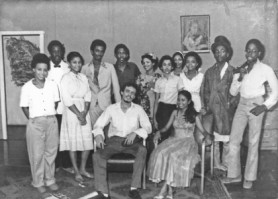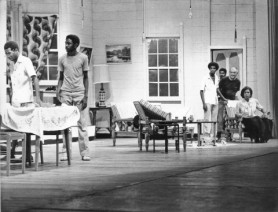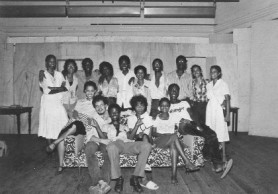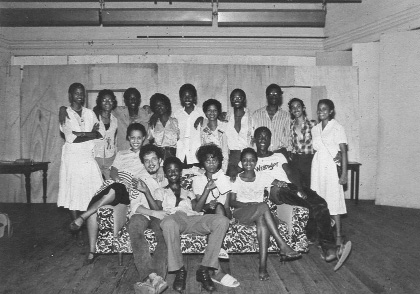Act 1
By Alex Graham
The story of Sir Ian Valz has beginnings that precede those so far mentioned in the various tributes and articles that have been written since the news of his passing hit us a few days ago.
Sir Ian Valz – Ian, as he preferred to be called – got his start in drama through his participation in the annual house plays competition at St Stanislaus College.

By the late ’70s when school drama had all but disappeared from Saints and the house play competition had become a thing of the past, Ian, as we were reminded by former Mayor Mavis Benn, was then a Public Health Inspector with the Georgetown City Council and was its first Sports and Cultural Officer.
He visited Saints during the elocution competition around 1977 and indicated that he wanted to revive drama in the school. An announcement was made and several students flocked to a classroom upstairs in the ‘new’ wing to join the drama group. As the winner of the Junior category in the elocution competition that year, I naturally turned up and joined the new drama group. ‘Toothpick,’ as he was known at the time, showed up with his best friend, another former Saints student who was involved in drama at school, Kim Vieira.

His leadership of this new drama programme at Saints led to the revival of the house play competitions in 1977 with three plays produced and staged at the St Rose’s auditorium. Following up on the success of the house plays, Ian had the St Stanislaus Drama Group entered in Guyfesta (The Guyana Festival of Arts) and won a Certificate of Excellence for The Valiant, Ian’s first directing foray outside of a school compound. Ian later won another Certificate of Excellence at Guyfesta for Director, in spite of himself.
The house plays in 1978 were Cockadoo, Strictly Matrimony and The Valiant, which were directed by students with guidance from Ian, ensuring that a high quality of theatre was delivered. In 1979 and 1980 the house plays were again on at the St Rose’s auditorium and, by virtue of the quality of theatre on show, were now on for two nights before the judges’ decisions and awards were announced. The plays in 1979 included Bond of Matrimony and A Flight of Sparrows, and in 1980 Shop at Sly Corner and Small Matters.

At the end of the annual house play competition in 1980 Ian was convinced that the talent he had showcased in the St Stanislaus Drama Group was as good as any in the country, and could hold their own in a full-length production at the Theatre Guild Playhouse for three nights. And so he embarked on a journey to stage the Miser, written in1668 by the French playwright Molière, at the Theatre Guild Playhouse.
The St Stanislaus Drama Group arrived at the Theatre Guild Playhouse in November 1980, with Ian Valz as Director (and playing the role at the Miser’s son), his friend Kim Vieira in the lead role (Harpagon) and a motley collection of schoolboys and girls trailing after them. The Theatre Guild Playhouse was neither a classroom at St Stanislaus nor the auditorium at St Rose’s. This was a different proposition. Enter Ron Robinson and Gem Madhoo. Ian was always a brilliant dramatist but needed to be shown the ropes around the big theatre. Ron and Gem ensured that he was comfortable at the Playhouse. (Ron told the Stabroek News that “their friendship dated back to the days of House of Pressure when Robinson worked alongside him as a sound engineer on the radio drama and also as a director.” Actually Ron met and worked with Ian earlier – in 1980 at the Theatre Guild Playhouse!)
By the time the three nights of performances were done, the reviews in the press were mixed but the audiences loved it and the show was held over. Ian Valz was a genius.
The Sunday Chronicle of November 9, 1980 declared “The Miser Comes Good,” and said, “The St Stanislaus Drama Group comprises one of the tidiest set of young players. With very mature and accomplished direction, they live their roles in a play that is mobile.” And of Ian: “Valz, who also plays a role of debonair but ‘out of pocket’ son of the Miser Harpagon, has a flair for altering or adapting Molière works without taking away that essential ingredient of the French playwright.” The reviewer added, “Molière himself would have been pleased with Valz’s adaptation.”
It is this adaptation of Molière’s work that led to the House of Pressure, first as a radio drama that Ron Robinson referred to and then as a breakthrough stage play at the National Cultural Centre. Ian had earlier said, “We need more theatres in the country… it’s a hell of a competition to get the Playhouse, which is more or less the established theatre place in the country. There is also a certain audience that we aim to capture and maybe even draw away from the Guild when we set up our own theatre.” Gem Madhoo-Nascimento reflecting this week remarked that “Valz’s plays also had commercial pull and he was responsible for attracting a grassroots audience to the National Cultural Centre.”
The rest of the story, up to Sir Ian Valz’s final scene is well recorded.

